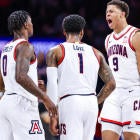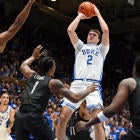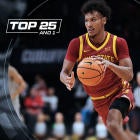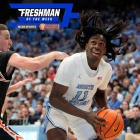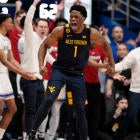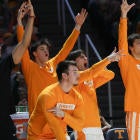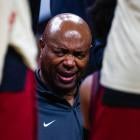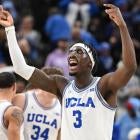
The University of North Carolina revealed on Thursday the NCAA's Notice of Allegations (NOA) against the school. It's a big public step forward in what has become the most notorious academic fraud case in the history of the NCAA. There are five allegations, four of them of the harshest order: Level I.
The 59-page Notice of Allegations is embedded at the bottom of this story.
Labeling North Carolina's era-spanning academic impropriety as a Level I "Severe Breach of Conduct," the NCAA's report references 18 years of "unchecked" coursework in the African and Afro-American (AFAM) Studies department at the crux of its investigation.
Officially, though, the NCAA's allegations date back to 2002 and go through 2011. That 18-year mark is a reference to the groundbreaking Wainstrein Report, which was released in 2014 and somewhat in coordination with the NCAA's decision to re-open its case against UNC last June.
The UNC case is a broad one, tough to interpret and now, somehow, even tougher to predict an outcome on. What we didn't see much of in the NOA: Sweeping, harsh, definitive allegations against current or former staff members with the UNC football or men's basketball team, the two high-profile programs who've had athletes go on the record in the past and claim they were aided in cheating in order to attain better grades.
Instead, the NOA looks at the academic side, the advisers who helped steer athletes and created a lack of institutional control. Here's the essentials of what you need to know, the timeline still to come and what we're still waiting to have cleared up.
1. The big aspect of this re-opened investigation was for the NCAA to link academic advantages to student-athletes. The AFAM's courses were available to everyone -- but now we see through the NCAA's investigation that players were specifically given advantages to gaining entry into those classes, essentially helping their chances of keeping their grades good and remaining eligible to play.
That's the biggie, and it's why the NCAA nailed UNC with a lack-of-institutional-control allegation. The NCAA alleges that from the fall of 2002 through the spring of 2011, academic counselors "leveraged their relationships" with UNC faculty to benefit athletes. This nefarious behavior stemmed from the African and Afro-American Studies department.
In short: the NCAA accuses UNC of enabling its AFAM department as being an easy way to stopgap poor academic performance and/or keep athletes eligible to play through the guise of phony lecture courses and paper classes that required no attendance and/or work.
2. The information supplied by the NCAA is undeniable, wide-ranging and almost entirely on UNC's academic advisers and counselors -- not the players or the coaches. The NCAA supplied 252 emails and/or correspondence spanning a number of sports in support of its first allegation alone. In total, its "exhibits" portion of the NOA details 732 pages and 325 exhibits/emails/correspondence that build its case.
The surprising part: men's hoops (27 references) and football (33) are not the primary targets. Women's basketball is the biggest violator. And Roy Williams is mentioned just once, in reference to an interview he gave to the NCAA. Williams has maintained his ignorance to this issue throughout.
3. The name we know now for sure that wasn't prominently discussed before: Jan Boxill. She was the chair of the faculty for UNC's Academic Support Program for Student-Athletes (ASPSA). She also was the director for the school's Parr Center for Ethics. And she's at the center of the women's basketball allegations, which take up most of the NOA and certainly indicate that women's hoops, not football or men's basketball, will be subject to the worst of the punishments down the road. (The soccer and baseball teams are also mentioned in the report.)
Boxill's role became clear when the Wainstein Report came out, but the NCAA makes no mistake that it's her inclusion and emails that paint the ugliest and perhaps dirtiest parts of the scandal.
"The AFRI/AFAM department created anomalous courses that went unchecked for 18 years," the NCAA's report states. "This allowed individuals within ASPSA to use these courses through special arrangements to maintain the eligibility of academically at-risk student-athletes, particularly in the sports of football, men's basketball and women's basketball.
"Although the general student body also had access to the anomalous AFRI/AFAM courses, student-athletes received preferential access to these anomalous courses, enrolled in these anomalous courses at a disproportionate rate to that of the general student body and received other impermissible benefits not available to the general student body in connection with these courses."
Julius Nyang'oro, the former chief of the AFAM and his former student services manager, Deborah Crowder, both refused (eight times between them) to meet and interview with the NCAA and UNC. These refusals boosted the NCAA's case against UNC in light of compounding evidence against Nyang'oro and Crowder, the two most notorious names with the case.
4. Know that, while this is a big headline in the here and now, this process really still has a long way to go. A case of this magnitude, which details fraud in many ways and in many departments, is tough to sift out in terms of punishment. So here's the timeline going forward:
-- UNC has a 90-day window from May 22, meaning it has until Aug. 20 (unless the university files for an extension, which is uncommon) to formally respond to the NCAA's allegations. It can opt to dispute any, or none, of them. UNC athletic director Bubba Cunningham said on a conference call Thursday afternoon he expects the school to file its response in August.
-- After UNC's response is received by the NCAA, the NCAA's enforcement staff will have 60 days to hold a "prehearing conference" with UNC and determine if any more violations need to be considered before moving to the next stage.
-- From there, the case moves on to the infractions-hearing portion, perhaps the most vital part, because it's the only time the NCAA and members from the University of North Carolina will meet face to face to discuss and debate the allegations -- behind closed doors.
5. In terms of punishment, it's a total guessing game at this point. The lack of mentions for men's basketball and football is certainly surprising. Remember, there is a new penalty structure, voted into effect by the NCAA last year, but in this case, it will not be applied. UNC will basically be given the better of two fates -- whenever everything has been finally hashed out, debated to death, and settled.
The timeline on that? It's still undetermined. The NOA's lack of mentions, specifically, for men's basketball and football don't absolve those programs. No way. Again, we're talking about four major allegations of Level I violations. Still, this was the NCAA's formal submission to UNC, and for the most part it went on what it could -- and it was heavily on the side of the former counselors, staff and advisers.
So, as the case drags on, it's looking more likely that UNC's forthcoming season on the men's basketball court, which has hopes of a Final Four-caliber team, could be clouded -- but not affected -- by this case.
Cunningham said he told his coaches the school is about halfway done with this saga. Given that it first began four years ago, and then started once more nearly a year ago, that indicates we won't have a final ruling on which programs will be hit in what ways until next spring at the earliest.









